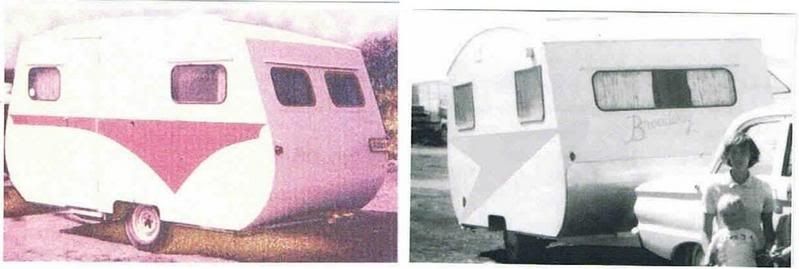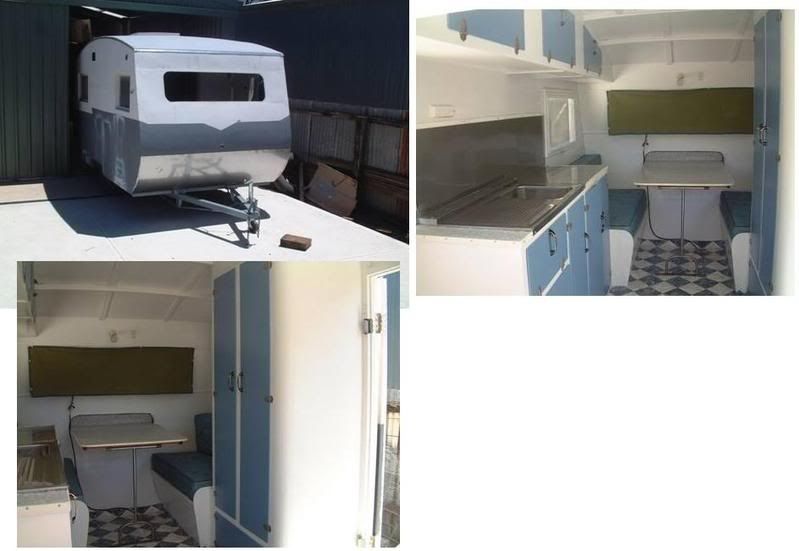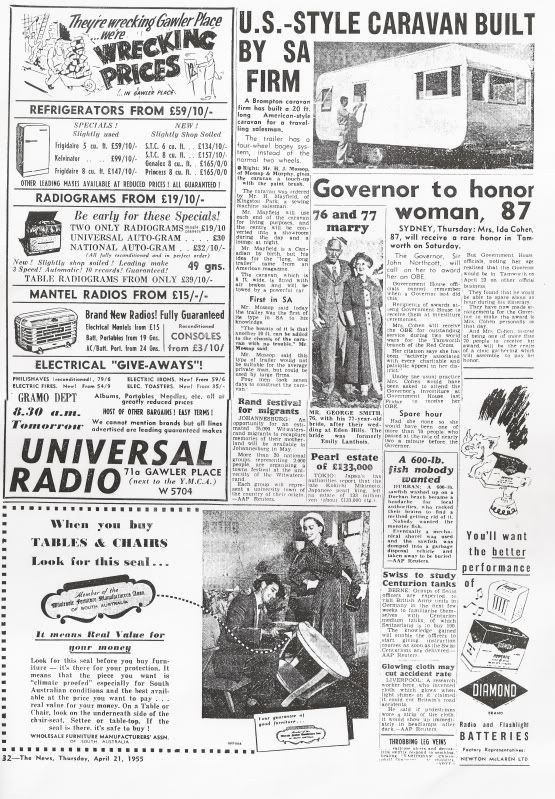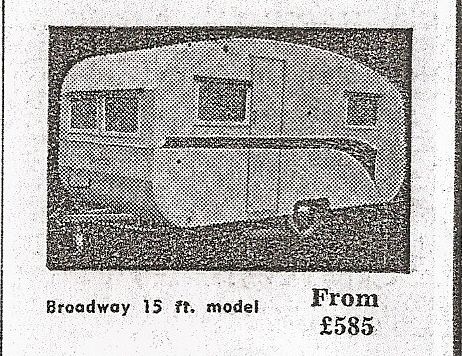|
|
Post by Franklin1 on Dec 12, 2007 20:59:13 GMT 10
Broadway caravans: Information posted by raym, Mar 10, 2007: These two photos are of Broadway caravans. The first photo the van has timber windows, this is the older of the two. The second has aluminium windows but both are the same shape and would be either 12 foot to 13 foot 6 inches long. ...Broadway built in SA by my father and his partner. They built vans from 1949 to 1960. ...My father built caravans in SA and I believe in 1957 he commenced using 25 foot x 7 foot x 3/8th inch plywood sheets for the side of his vans, he continued this method until 1960s.
|
|
|
|
Post by Franklin1 on Jan 17, 2008 22:10:09 GMT 10
Broadway caravan: (source: posted by Mark T, Dec 14, 2005, on behalf of Mike, who wrote: "Hello Mark, Well on the way to getting the van into better order.")
ADDENDUM - January 2023: Additional photos of Mikeosborne's 1958 Broadway posted here on 14 April 2006: Upon purchase: _A.png?width=960&height=720&fit=bounds) And after restoration with Mikeosborne's 1963 Alvis: .png?width=960&height=720&fit=bounds)
|
|
|
|
Post by Don Ricardo on Oct 28, 2008 8:03:11 GMT 10
In response to a discussion on 28 October 2008 about Samson's Castle Windcutter caravan and KB3's Hawthorn caravan, Raym wrote: HI All,
Neither van is a Broadway. Both appear to be Rowe Vans. My father never put in port holes to my knowledge, however all Rowe Vans had port holes. Their motto was "There's no van like a Rowe Van". They were sold by Keith Odges.
As suggested Badge Engineering did occur in the late fifties, Broadway Vans were re badged Wayfairer. To date, I have not seen one of these on the forum.
RaymRaym - Is the Wayfairer you refer to the same company as the one referred to in this thread? The earlier bondwood vans look the same as your father's except that I note that they have round wheel arches rather than your father's distinctive rectangular ones. Pretty impressive if you can sit an FX on top of them! Don Ricardo |
|
raym
Full Member
  
Posts: 128
|
Post by raym on Jan 16, 2012 20:05:14 GMT 10
This is a newspaper clipping from The Adelaide News – the Adelaide evening newspaper dated Thursday 12th April 1955. It is about a caravan built by my father and his partner who traded as Broadway Caravans. It was a 20’ long tandem, commercially built although a one off special.  As the wording on the newspaper clipping is hard to read it is retyped as follows:- A Brompton caravan firm has built a 20 ft. long American-style caravan for a travelling salesman. The trailer has a four wheel bogey system, instead of the normal two wheels. • Right: Mr. H.J. Mossop, of Mossop & Murphy, gives the caravan a touch-up with the paint brush. The caravan was ordered by Mr. H. Mayfield, of Kingston Park, a sewing machine salesman. Mr. Mayfield will use each end of the caravan for living purposes, and the centre will be converted into a showroom during the day and a lounge at night. Mr. Mayfield is a Canadian by birth but his idea for the “long, long trailer” came from an American magazine. The caravan which is 8 ft. wide, is fitted with air brakes and will be towed by a powerful car. First in SA Mr. Mossop said today the trailer was the first of its type in SA to his knowledge. “The beauty of it is that another 10 ft. can be added to the chassis of the caravan with no trouble” Mr. Mossop said. Mr. Mossop said this type of trailer would not be suitable for the average private man, but could be used by large firms. Four men took seven days to construct the caravan. raym |
|
raym
Full Member
  
Posts: 128
|
Post by raym on Jan 16, 2012 20:28:50 GMT 10
BROADWAY CARAVANS
History of Broadway Caravans 1949 – 1961
After the World War 2 Mr. Herbert (Bert) Mossop and Mr. John (Spud) Murphy both carpenters & joiners were working for Mr. Bruce Dawe when they decided to have a go on their own. John’s brother, Mr. Frank (Danny) Murphy, also a carpenter joined them. They worked for several years manufacturing and installing kitchens and doing small building jobs. The kitchens were manufactured in the back yard of John and Danny’s parents home located at 50 John Street, Hindmarsh, South Australia. This road has been re-named South Road and the house still stands. In 1949 Mr. Eddie Kessner approached them to build a caravan. He built the chassis and Mr. Brooks sold them. This arrangement went on for some time. At the commencement of the caravan building Danny left to do his own thing and they employed Joe Pallant. After this they met Mr. Bruce Atkin who ran a C.O.R (Commonwealth Oil Refinery) motor garage on Port Road just behind the SA Brewery. At the garage there was enough room to sell approximately 3 or 4 used cars, so Bruce began selling the vans. If the garage became too congested he would simply put the vans in the parklands over the road and sell from there (try that one today and see what would happen). Bruce’s brother-in-law, Rex Murphy (no relation to John), rented part of the garage workshop to carry out his welding and fabrication business. They approached Rex to build the chassis which he did for a number of years. He later went on to build horse floats which he called Holdfast, still plenty on the road today. Up until this point the vans did not have a name, as with many older houses and some other buildings it was a practice to give them a name. The old C.O.R garage was named Broadway; this was simply taken to name the vans.
Page 1
Approximately 100 vans and shells were built at John Street, Hindmarsh, all 12 or 15 foot x 7 feet with either sliding glass windows or louvers. All vans were constructed with 1 ¼ inches x ¾ inch Blackwood or Australian Oak frames fixed together with 2 inch nails. The inside lining was standard hardboard externally tempered hardboard both 1/8 inches thick. At additional cost you could have 1/8 inch waterproof ply. The floors were Pinus floor boards nailed to 2 inch x 2 inch Jarrah bears fixed to the chassis. This changed later to ½ inch plywood fixed directly to the chassis with P.K. (Parker & Kolman) self tapping screws. The cupboards were made of Pinus frames and 1/8 inch ply or hardboard lining 3/8 inch ply for seat tops and shelves. The front frame of the cupboards was WRC (Western Red Cedar). The roof was Canite covered with 32 oz. canvas with several coats of silver frost paint. The windows were plywood with a timber frame and the glass held in by an “H” rubber. Later they used a more advanced “H” rubber with an insert, much easier to install. Floor coverings were 9 inch x 9 inch vinyl tiles; bench tops and table were Laminex with plastic edging, fixed with escutcheon pins. Most hardware was purchased from Colton, Palmer and Preston. Special caravan components came from Clipper Caravans as they had a spare parts shop. Bedding from Elite Bedding, wheel arches, water tanks and ice box liners from Highview Manufacturing (sheet metal workers). Harry Muggleton Electrical did all the electrical work and Errey Sign Writing did the pin striping and names. Some vans had a transfer for the name and the early vans had a small brass plate fixed inside the van, I think it said “manufactured by J.W. Murphy and H.J. Mossop 50 John Street, Hindmarsh and possibly a phone number. (I would love to find one of these!) In approximately 1953 they moved to larger premises, a rented shed at No. 1 Fifth Street, Brompton. The design was upgraded and the sizes varied. At this time, Rex Murphy stopped building chassis so they contacted Mr. Dick Bassett, who was the owner of Globe Trotter Caravans, he was more than happy to supply the chassis as he supplied chassis to several caravan builders Page 2
This went on for a few years and the last chassis were supplied by J.C. Forbes, he also made chassis for many caravan builders in South Australia. Both Holdfast and J.C. Forbes had their own couplings cast with their names on them. Some still exist today. Bruce eventually moved from the C.O.R garage as it was to be demolished and turned into a B.P. Bruce then opened a wrecking yard on the corner of Grand Junction Road and Plymouth Road, Rosewater and sold the vans from that location. This was just opposite the Starline Drive-In Theatre and Bruce arranged for an advertisement to be screened at the drive-in. Some vans were now sold to Wayfairer in Warracknable Victoria. These would be towed to Keith in South Australia behind Bert’s or John’s 1951 and 1950 Humber Super Snipe, where they would meet the representative from Wayfairer at 11.00am. The last van, Wayfairer had on consignment they could not sell due to the economic times and eventually my father drove over to Victoria and picked it up, eventually selling it in South Australia.
In 1957 they started making solid ply sided vans, this ply was purchased from LeMessurier Timber Co. at Port Adelaide. The ply was in sheets 7 feet (2.1meters) X 25 feet (7.5 meters) X 3/8 inches (10mm) thick, it was coated with a plastic coating for waterproofing, the same as formwork plywood. The sides were simply cut out of the ply timber, frames were installed around the door and windows and the cupboards did the rest. This was very convenient size sheet. A sheet made two (2) sides for a 12 foot van. They were building vans up to 18 foot by this method. The front roof and backs were still framed and covered with 1/8 inches masinite or plywood. This eventually gave way to an outer skin of aluminum and the sides were painted. Finally they began adhering aluminum to the ply sides to make an all aluminum van.
Page 3
They were just about to experiment with a full steel frame covered with aluminum when in 1959 a credit squeeze occurred. Caravans still being a luxury and expensive were hard to sell and this bought an end to their manufacture. Many of caravan manufacturers at the time were in South Australia mostly small factories. Some with interstate factories like Viscount Clipper etc. This credit squeeze bought an end to these small companies. The only South Australian to survive was Roadmaster and still going today. By the time things got better and the money started to flow it was too late for these small manufacturers and the big companies took over in Victoria and NSW with production, line type methods and of course full aluminum finish.
In 1955 they built a 20 foot X 8 foot van, this was the biggest van built in South Australia at the time. This featured in The News, South Australia’s evening newspaper, copy of photo and story below. I can remember my father saying that he never received final payment for this van. It is interesting to note that this took 4 men 7 days to construct, not bad considering that most work was carried out with hand tools. The only machines they had were a 14 inch circular saw with single dowel drill on the side, 6 inch buzzer, 12 inch thicknesser, 12 inch band saw, air compressor for spray painting, a couple of ¼ inch electric drills, a 9 inch sander/grinder and a orbital sander for rubbing down the undercoat.
Not a bad effort, they ran this business without any registered name, no formal contacts or partnerships, all business was done on a handshake. No records were kept not even a photograph of the vans. Unfortunately I did not record any of this while my father and mother were alive but his partner John and his wife are still alive and have helped with this information.
Page 4
On weekends, my father would build his own vans which he hired out as a side business. I spent many enjoyable weekends helping him build these vans and my brother and I would get the hire vans in and out after school as Dad was often still at work when people would come to pick them up. Many a time I would have to wire a plug on their car to make the lights work all free of charge.
My father always said there were three things to consider when building a caravan –
1. Cost - Of course
2. Weight
3. Strength / Durability
They made their frames from hardwood as this gave strength and held the nail from popping out, however, this was not light or cheap. Some manufacturers, even today, use Pinus – cheap and soft, but light.
Plywood is half the weight of hardboard but in the 50s and 60s ply was approximately double the price of hardboard, so they gave you the choice of which lining you wanted. Most customers went for hardboard due to the cost of the plywood.
My father would not have a phone connected to the factory, as this interfered with work. He had this at home and most days would go home for lunch and place orders etc. Go to the bank and make up the wages while he had lunch.
Ray Mossop
Page 5
|
|
|
|
Post by Don Ricardo on Jan 17, 2012 20:48:07 GMT 10
Hi Raym, Thank you so much for your last two posts, and all the wonderfully detailed information you've provided about Broadway caravans. It's fascinating to read about the construction methods and materials your father and John Murphy used to build the vans - and all based on a gentleman's agreement! Can't imagine that happening today, more's the pity. I was also interested to read about some of the factors that led your father and John to build the vans in the way they did - cost, weight and durability. One aspect of the story that I was interested to read was about the connection with Holdfast couplings and horse floats. After the Mount Gambier V V Nationals in 2008, Reddo posted the following photos of a caravan he saw in Portland (Vic) which had 'Holdfast' on the side:   At the time (and since) none of us could figure out how this van fitted into the scheme of things, but reading your post has made me think that possibly the van has a Holdfast coupling, and that at some stage someone figured that that might be its brand name and so wrote it on the side. However, I am wondering if the van could have been one of your father's? It is a different shape to the Broadways shown on this thread, but could it be an earlier model? I note that it has the same rectangular wheel arches that seem to have been typical of Broadways. I will be interested in your thoughts on this...    Something that made me smile (kindly, not derisively I assure you) was the comment by your father referred to in the Adelaide News article regarding the 20 ft van he built: "Mr. Mossop said this type of trailer would not be suitable for the average private man, but could be used by large firms."Dona Ricardo and I have just returned from being out on the road. From a V V perspective you can't help noticing that these days 16ft vans are the midgets. A large proportion of vans, especially those behind 4WD's, seem to be 20 ft plus. I wonder what your father would make of them...and all the equipment that modern caravanners now seem to think is essential? Thanks again for your posts, and for taking the trouble to record the info. Just wonderful information to have on the forum. Don Ricardo |
|
raym
Full Member
  
Posts: 128
|
Post by raym on Jan 18, 2012 21:01:55 GMT 10
Hi Don
Firstly on my post I stated that the date of the paper as being Thursday 12th April 1955 in fact if you look closely at the article you can see it is Thursday 21st April 1955.
Re: The Holdfast Caravan, it does not appear to be built by my father, however it may have been built by Rex Murphy (Holdfast Horse Floats) as a one off for his own use. Or, it may have been as you said someone just took the name from the coupling
raym
|
|
|
|
Post by Don Ricardo on Dec 15, 2013 21:07:38 GMT 10
The following photo of a 15 ft Broadway caravan appeared in an advertisement for the Caravan Centre in the 1958 edition of Winser (see full advertisement here). Thanks to Raym for providing this information. As indicated in the posts above, his father was the builder of Broadway caravans.
|
|